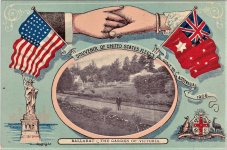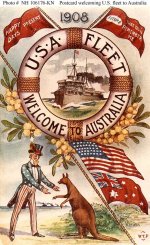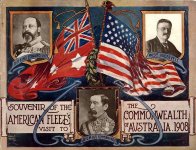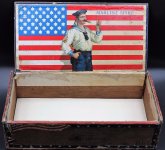The official history of the United States flag appears to be omitting a few intricate details. It's hard to say what the true meaning of those details is, but the sheer fact of them being omitted prompts a few questions to be asked. Wikipedia chooses not to mention certain US flags in its "official" pages dedicated to the topic of the United States flag and its history. Other semi-official web sources also choose not to mention these "flag variations"

The First Official United States FlagThis 13-Star Flag became the Official United States Flag on June 14th, 1777 and is the result of the congressional action that took place on that date. Much evidence exists pointing to Congressman Francis Hopkinson as the person responsible for its design.The only President to serve under this flag was George Washington (1789-1797). This Flag was to last for a period of 18 years. Each star and stripe represented a Colony of which there were thirteen, united nearly one year earlier by the Declaration of Independence.
Which one was the first?
[

Betsy Ross flagThe Betsy Ross flag is an early design of the flag, popularly – but very likely incorrectly – attributed to Betsy Ross, using the common motifs of alternating red-and-white striped field with five-pointed stars in a blue canton. Grace Rogers Cooper noted that the first documented usage of this flag was in 1792. The flag features 13 stars to represent the original 13 colonies with the stars arranged in a circle.

Other DesignsAs the exact pattern of stars was not specified prior to 1912, and the exact colors not specified prior to 1934, many of the historical U.S. national flags shown below are typical rather than official designs.
Oil painting showing historical U.S. flags.

Historical progression of designsSince 1818, a star for each new state has been added to the flag on the Fourth of July immediately following each state's admission. In years which multiple states were admitted, the number of stars on the flag jumped correspondingly; the most pronounced example of this is 1890, when five states were admitted within the span of a single year (North Dakota, South Dakota, Montana, and Washington in November 1889 and Idaho on July 3, 1890). This change has typically been the only change made with each revision of the flag since 1777, with the exception of changes in 1795 and 1818, which increased the number of stripes to 15 and then returned it to 13, respectively.

Below is the set of sources used up to this point:


I have never heard of any six-point star designs used during the Civil War. Meanwhile according to the official sources it could only be the 1777 Francis Hopkinson's flag. Using 1777 flag in the 1860s makes very little sense.
During the 19th century, for its smaller-sized ensigns, the U.S. Navy used a 13-star flag which became known as "boat flag". The Navy appears to have started this practice in the 1850s and is formally documented in the Navy Regulations of 1864. The reason for the lesser number of stars was so that the stars in a smaller size flag would have greater visibility at a distance.
1899. "Boat drill - U.S.S. New York."

In 1912, President President Taft formally recognized the Navy's longstanding use of the 13-star ensign in Executive Order 1637, which defined the flag's precise dimensions. The "boat flags'" formal recognition lasted just four more years however, as President Wilson acting through Secretary of the Navy Josephus Daniels discontinued the practice in 1916 with Executive Order 2390, after which all ensigns were supposed to have the full complement of stars.

Stars of DavidAnd a totally separate group of the United States flags emerges in 1908. Coincidentally, this is the same year when the Great White US Fleet was in the middle of its "Peace Mission" around the World.


The Simcoe Yorktown Flag 1781

During the battle of Yorktown in October, 1781, this flag flew on the right flank of the American troops. A 26 year-old British Lieutenant Colonel named John Graves Simcoe in command of the Queen's Rangers at Yorktown painted this from his station across the river.
Many flag historians believe that the flag was between Simcoe and his position at Gloucester Point and the sun, thus resulting in the strange colors he perceived. After the war Simcoe went on to become Upper Canada's first lieutenant-governor and probably the most effective of all British officials dispatched from London to preside over a Canadian province.
The United States-French Alliance Flag 1781-82
 In 1781 and 1782, in honor of the end of the American Revolutionary War and the help of France in that conflict, a special U.S. Flag appeared. It consisted of 13 red and white stripes with a very long (11 stripes long) canton bearing either 12 or 13 white stars and a gold fleur-di-lis. The stars are shown in contemporary illustrations either as 5 pointed or as 6 pointed in rows of three (with a single star below if there are 13) and the fleur at the top.
In 1781 and 1782, in honor of the end of the American Revolutionary War and the help of France in that conflict, a special U.S. Flag appeared. It consisted of 13 red and white stripes with a very long (11 stripes long) canton bearing either 12 or 13 white stars and a gold fleur-di-lis. The stars are shown in contemporary illustrations either as 5 pointed or as 6 pointed in rows of three (with a single star below if there are 13) and the fleur at the top.
13 Star U.S. Flag - Grand Luminary design
 This 13 star Grand Luminary flag is an enigma wrapped in a riddle and surrounded by mystery. The flag is made of wool bunting with six-point, linen stars gracing the canton. These features point to manufacture during the early federal period, especially the six-pointed linen stars, a common feature of 18th century flags.
This 13 star Grand Luminary flag is an enigma wrapped in a riddle and surrounded by mystery. The flag is made of wool bunting with six-point, linen stars gracing the canton. These features point to manufacture during the early federal period, especially the six-pointed linen stars, a common feature of 18th century flags.
This interesting, late 19th or early 20th century (ca 1889-1920) cigar box label has imagery that is especially modernistic for its period of manufacture. It features a 42 star American national flag with 6-pointed stars on a beautiful, cornflower blue canton. Though the reason for its use is unknown, this type of star is seen on other objects of this particular period. In present times one might identify the design as the Star of David, though this symbol, also known as the Shield of David, was not in widespread use by members of the Jewish faith until further into the 20th century.



What about this 1867 one from Utagawa Yoshitora:

Related on StolenHistory.ORG

KD: In my opinion, something very wacky is being withheld from the public knowledge. Why these "Star of David" flags are not officially mentioned is a very good question to ask. The only issue - there is nobody to ask about it.
US Flag
At the time of the Declaration of Independence in July 1776, the Continental Congress would not legally adopt flags with "stars, white in a blue field" for another year. The flag contemporaneously known as "the Continental Colors" has historically been referred to as the first national flag.The First Official United States Flag
Which one was the first?
[
Betsy Ross flag
Other Designs
Oil painting showing historical U.S. flags.
Historical progression of designs
- Flag of the United States
- History of the flags of the United States
- History of the American Flag | A Capitol Fourth
- The Star of David: The 1777 Stars and Stripes
- Flag timeline
- USFlag.org - The First United States Flag
Under the radar US Flags
At some point I noticed that there were no photographic pictures of the United States flag prior to the Civil War (1861-1865). What could be a possible reason for that?
Hopkinson's Flag

It was interesting to learn different little things pertaining to the US Flag. For example this 13 star boat flag. And I smell a rat here.
During the 19th century, for its smaller-sized ensigns, the U.S. Navy used a 13-star flag which became known as "boat flag". The Navy appears to have started this practice in the 1850s and is formally documented in the Navy Regulations of 1864. The reason for the lesser number of stars was so that the stars in a smaller size flag would have greater visibility at a distance.
1899. "Boat drill - U.S.S. New York."
The Navy flag Rat

I find it highly suspicious that for over 60 years the United States Navy flew unauthorized colors on "smaller boats" displaying 13 stars due to visibility reasons.- first of all, they make it sound that visibility of the flag depended on the size of the ship.
- and secondly, this quick "executive order" succession suggests that something had to be "officialized" and quickly taken out of the equation.
Stars of David
- Real mission of the 1907-1909 US Great White Fleet, what was it?
- 1908 Messina destruction: earthquake or guns?
AUSTRALIA
6-point vs. 8-point
A Red Ensign with the Commonwealth/Federation Star




And finally this...

6-point vs. 8-point
A Red Ensign with the Commonwealth/Federation Star



And finally this...
More 6 Point Starred US Flags
The Bauman Yorktown Flag 1781

Within days of the British surrender at Yorktown on on October 19, 1781, an American artillery officer named Major Sebastian Bauman (2nd New York Artillery Regiment) drew a map with this flag pictured on it. It was later engraved by Robert Scot of Philadelphia and published. Bauman had carefully surveyed the terrain and battle positions at Yorktown, at the siege of Yorktown. Bauman had emigrated to America from Germany after service in the Austrian army. During the Revolution, he served in the campaigns in New York, New Jersey, and Pennsylvania, and was in command of the artillery at West Point, before joining Washington at the siege of Yorktown. The Bauman Yorktown Flag 1781
The Simcoe Yorktown Flag 1781
Many flag historians believe that the flag was between Simcoe and his position at Gloucester Point and the sun, thus resulting in the strange colors he perceived. After the war Simcoe went on to become Upper Canada's first lieutenant-governor and probably the most effective of all British officials dispatched from London to preside over a Canadian province.
The United States-French Alliance Flag 1781-82
13 Star U.S. Flag - Grand Luminary design
A late 19th century Hand-Made American Flag with 13
Six-Pointed Stars forming an Even Larger Six-pointed Star of David

Six pointed stars on American Flags are a very rare trait, shared only by a handful of known examples. The same can be said of flags with cantons arranged in a six-pointed great star configuration. This configuration of stars on a flag of pieced and sewn construction is known on less than four or five surviving flags. The pattern is very similar to the star pattern seen on the official Great Seal of the United States. The first die of the Great Seal, cast from brass in 1792, featured a "glory" of six pointed stars arranged to form a single six pointed star. Although the "glory" on the Great Seal is oriented to with a single star at the top, the "glory" pattern on this flag is rotated 90 degrees.Six-Pointed Stars forming an Even Larger Six-pointed Star of David
12 Six-Pointed Stars, Neufchâteau, Vosges, France

This beautiful liberation flag of 12 stars and 11 stripes is visually striking with many rare traits such as the use of six-pointed stars, the canton resting on the red "blood" stripe, the use of white stripes as the first and last stripes of the flag, a slight swallow-tail form, and a banner staff and cord so the flag could be hung vertically. The seller of the flag relayed this story, from the man from which they acquired the flag: "He tells me that the flag comes from the town of Neufchâteau in the Vosges where he used to live. [It] belonged to a well off family in town and during the war in 1944-45 after the liberation of the region there was a column of German soldiers which came up the Rhone Valley and passed through the town. When the Germans saw the liberation flags hanging from the windows they stopped and rounded up everyone who had a flag and put them in the town plaza to shoot them but that since the Americans were not far they decided to run off fast instead. I asked him about the twelve 6 pointed stars and he told me that since the French weren't always sure how many stars the American flag had they would just use the space they had." 48 Stars, Pont Aven, Bretagne, France

This flag of 48 six-pointed stars was found in Pont Aven, France, which is located in Bretagne, not far from Normandy, France. The original owner of the flag indicated that the flag was inspired by the liberation of Pont-l'Abbe in Normandy. The canton of the flag is made of silk, with small six-pointed cotton stars sewn hand sewn to the canton. The stripes are machine sewn and appear to be made of either nylon or rayon. A wiry metallic bullion fringe surrounds the flag, and is likely repurposed upholstery or curtain trim. The flag has a sleeve hoist and the canton is inset into the third white stripe, nearly resting on the red "blood" stripe. American flags with stars having other than five points are very rare.This interesting, late 19th or early 20th century (ca 1889-1920) cigar box label has imagery that is especially modernistic for its period of manufacture. It features a 42 star American national flag with 6-pointed stars on a beautiful, cornflower blue canton. Though the reason for its use is unknown, this type of star is seen on other objects of this particular period. In present times one might identify the design as the Star of David, though this symbol, also known as the Shield of David, was not in widespread use by members of the Jewish faith until further into the 20th century.
US Peace Flag
Officially non-existent Peace Flag

It appears that in 1908, someone out there had a slightly different understanding of the US Peace flag, and considered it something official. Today we are being told that such a flag is some Urban Legend.Officially non-existent Peace Flag
What about this 1867 one from Utagawa Yoshitora:
Related on StolenHistory.ORG
Last edited:


